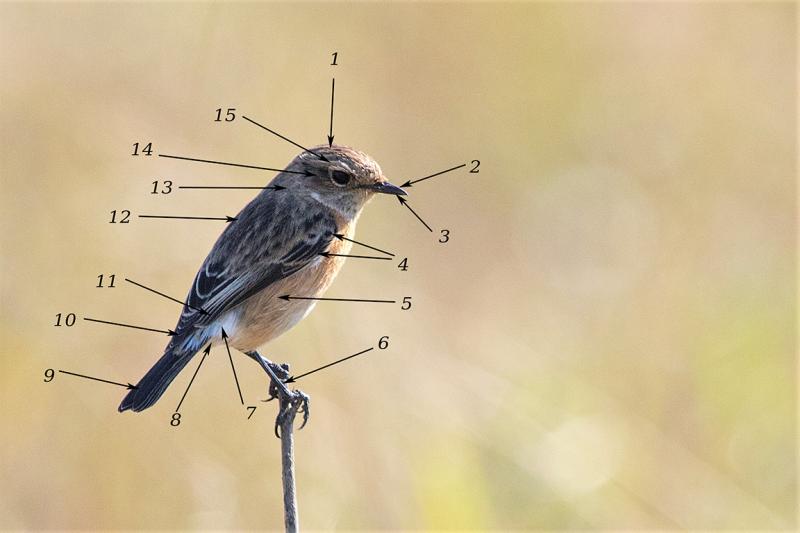Here is another opportunity to go hands on with a range of activities that will check what you know and give you opportunities to look further into the lives of birds. We look at ways to make bird identification easier and more interesting.
1. In a poster entiltled "Advice for Bird Watchers" make a list of the points you would include. Refer to Section 3 for help.

African Stonechat
2. Referring to the picture above, match the number with the name of the part. Refer to Section 1 for help.
Vent ( ) Tail ( ) Upper Mandible ( )
Mantle ( ) Flank ( ) Primaries ( )
Supercilium ( ) Nape ( ) Wing Coverts ( )
Rump ( ) Upper Tail Coverts ( ) Tarsus ( )
Lower Mandible ( ) Ear Coverts ( ) Crown ( )
3. Using examples either in Section 2 or in books and other websites, give three examples of bird species where the male is different from the female. Describe the plumage differences in each case.
4. Apart from sexual dimorphism( differences in male and female birds) what other factors make identifying the species of a bird difficult? (See Section 2)
5. What are the advantages and disadvantages of using a tripod when photographing birds? (See Section 4)
6. Why does a bird photographer need a telephoto lens?(see Section 4)
A Bit Harder
7. What is a diagnostice feature when describing a bird? Give three examples of diagnostic features and describe them in detail (Sections 1 and 2).
8. Behaviour can also aid identification. Give three detailed examples of behaviour that helps to identify a species or group of species (Section 3).
7. What is the difference between a zoom lens and a prime lens? What are the advantages and disadvantages of using a zoom lens compared with a prime lens(Section 4)
8. "How to take a good bird photograph". What advice would you give to someone new to the hobby(Section 5)?
Over To You
9. Time to practice your observation skills. You should have a Field Record Book. You could buy one ready to use. Alternatively, you could use my format below, or devise one of your own. All the information you need for a good field record is included below. It should be a practical pocket size. If you can take pictures, all the better*.
Spend a few hours observing your local species keeping a record in your field book. You may be surprised at how many there are.
10. Research online for bird watching locations in your area. Pay a visit and spend a couple of hours strolling around or visiting a hide. Standing quietly and patiently in a shady, leafy spot for several minutes can produce good results.
11. Find out about your local bird watching group and whether it would be a good idea to join them.
*If you1 want to take up wild life photography, you will need to spend a few Pounds/ Dollars/Yen/Euros etc. You can buy a second hand consumer level camera fit for purpose for very little. There are second hand zoom lenses in the 70-300mm, 100-300mm range that are also surprisingly cheap although you should be prepared to pay more for a better lens. 200 to 500 USD should be enough for a basic kit. For a long time I managed with a basic 70 -300mm lens and a cheaper consumer SLR camera that were adequate. In fact it took some of the pictures on this site. They won't be professional standard but good enough to enable you to identify the bird when you get back home. You could also try one of the SLR bridge cameras that have non detachable lens but can pack a powerful zoom. Resolution isn't good at greater distances and it can be really hard to use the view finder. Again, there are one or two photographs on this site take with a bridge camera as they are light, compact and easy to carry.
Really Challenging
12. Prepare an in class presentation, or a talk to your local bird watching community, on how to contribute to bird conservation projects in your area. Check online for local initiatives and what organisations are doing worldwide.
13. Research a local bird specieis in your area that is defined as Threatened or Near Threatened by the IUCN. Write a description of the bird referring to habitat, feeding habits and other behavioural traits, explaining the challenges facing the bird and how conservation initiatives can help.